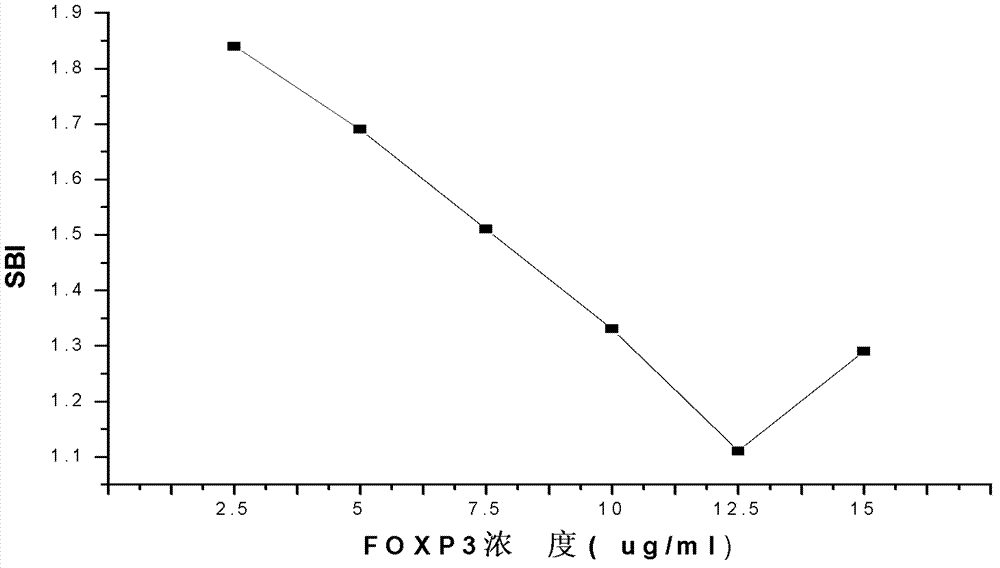Tumor marker FOXP3 auto-antibody and application thereof
A tumor marker, antigen polypeptide technology, applied in the field of immunology, can solve the problems of low sensitivity and poor specificity, and achieve the effect of high sensitivity and high specificity
- Summary
- Abstract
- Description
- Claims
- Application Information
AI Technical Summary
Problems solved by technology
Method used
Image
Examples
Embodiment 1
[0030] FOXP3 The process of binding antigen polypeptide to serum and plasma IgG
[0031] It can be seen from Figure 1 that when the FOXP3 concentration is 5-12.5 μg / ml, the SBI value gradually decreases with the increase of the concentration, and when the FOXP3 antigen polypeptide concentration is 12.5-15 μg / ml, the SBI value gradually increases with the increase of the concentration . This SBI binding curve shows that when the FOXP3 antigen polypeptide is at a lower concentration of 5 μg / ml (0.5 μg / well), the bottom of the 96-well microtiter plate is not covered, resulting in high non-specific reactions, so the SBI value at this time When the concentration of the FOXP3 antigen peptide increases, the antigen gradually covers the entire bottom of the plate, its blocking effect appears, and the non-specific reaction gradually decreases. The non-specific reaction is the lowest when it reaches 12.5 μg / ml. The specific binding between FOXP3 antigen polypeptide and IgG antibody b...
Embodiment 2
[0033] kit preparation
[0034] Tab.2 Antigen coating buffer Sodium azide 0.1g PBS (0.01M, pH7.4) 100ml Store at 4°C
[0035]
[0036]
[0037]
[0038]
[0039]
[0040] 2 operations
[0041] (1) Coating: Dilute the working antigen and reference antigen with coating solution to the working concentration, coat on the microtiter plate, and store overnight at 4°C.
[0042] (2) Add plasma (primary antibody): Wash the ELISA plate 3 times with washing buffer, dilute the plasma to an appropriate concentration with the analysis solution, generally 1:200-1:500, 100 μl per well, incubate at 25°C or room temperature 2~3h;
[0043] (3) Secondary antibody incubation: wash with washing buffer for 3 to 5 times, dilute the secondary antibody standard solution IgG with the analytical solution, add 200 μl to each well, and incubate at 25°C / room temperature for 2 hours;
[0044] (4) Color development: wash with washing buffer 3 to 5 times, add 100 ...
Embodiment 3
[0047] Detection of FOXP3 auto-IgG antibody in patients with lung cancer
[0048] 1 sample collection: 501 plasma samples from tumor patients and healthy individuals were collected. The healthy group consisted of 227 cases, with an average age of 57.07±10.36 years, including 134 males and 92 females. The lung cancer group included 274 cases, with an average age of 57.5±9.2 years, including 177 males and 97 females. The healthy group and the lung cancer group were matched in gender and age and were comparable ( P >0.05)
[0049] 2 test results : From Tab.10-11, it can be seen that the area under the ROC curve (AU) of the IgG antibody ROC curve of the FOXP3 antigen polypeptide in the plasma of patients with lung cancer was 0.7, the sensitivity was 20.4%, and the specificity was 90.3%. The positive rate of IgG antibody binding to FOXP3 polypeptide antigen in the plasma of patients with lung cancer was significantly higher than that of the healthy group ( Z = -7.68, P <...
PUM
| Property | Measurement | Unit |
|---|---|---|
| Sensitivity | aaaaa | aaaaa |
| Sensitivity | aaaaa | aaaaa |
Abstract
Description
Claims
Application Information
 Login to View More
Login to View More - R&D
- Intellectual Property
- Life Sciences
- Materials
- Tech Scout
- Unparalleled Data Quality
- Higher Quality Content
- 60% Fewer Hallucinations
Browse by: Latest US Patents, China's latest patents, Technical Efficacy Thesaurus, Application Domain, Technology Topic, Popular Technical Reports.
© 2025 PatSnap. All rights reserved.Legal|Privacy policy|Modern Slavery Act Transparency Statement|Sitemap|About US| Contact US: help@patsnap.com



